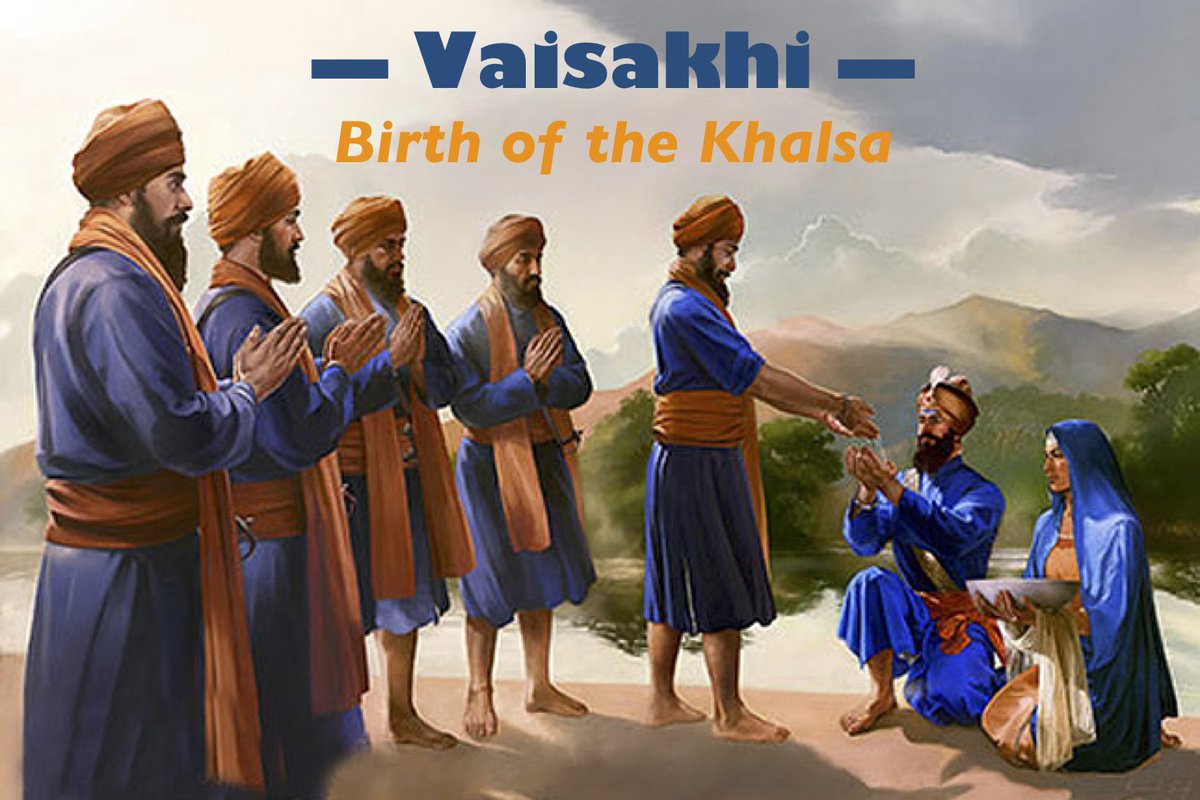Happy #Vaisakhi, commemorating the birth of the #Khalsa:
By the advent of Guru Gobind Singh, the masses in the field were flocking to align themselves with this community whose leaders were sacrificing their lives to resist and destroy the power of slave-masters.
By the advent of Guru Gobind Singh, the masses in the field were flocking to align themselves with this community whose leaders were sacrificing their lives to resist and destroy the power of slave-masters.
After 500 years of Shabad history developed by the Bhagats & the Gurus, formation of the Adi Granth & construction of Harmandir Sahib & Akal Takht, the next stage in the struggle to secure human dignity was to establish national status for the participants in the Sikh Revolution.
Guru Gobind Singh did this by uniting Panth and Granth in a body called the Khalsa (sovereign) which could enrich the world at large.
In 1699, Guru Gobind Singh stood before tens of thousands of his followers who had traveled from far and wide to assemble at Anandpur Sahib, the city originally planned by his father in 1665.
Speaking to the assembly, he began by calling for five followers to volunteer their heads in sacrifice. He took the first volunteer inside his tent and returned, alone, carrying a sword covered in blood.
He requested another volunteer and repeated this process until, at last, he returned with all five, alive but now dressed as kings in turbans.
The five came from diverse castes and far-flung geographical regions. One was from Delhi, one from Gujarat, one from Karnataka, one from Lahore, and one from Orissa. Four of them were originally members of the oppressed classes.
Now, however, the differences and divisions of their old identities were to be abandoned as the Guru stripped them of their caste names and baptized them all as “Singh” (lion). Instead of “worms” these men were to be lions.
“From now on, you have become casteless,” declared the Guru. In a single statement, he upheld the equality of men and women, the shared humanity of all people, the plight of the poor, and the distinctiveness of the Sikh religion.
“No ritual, either Hindu or Muslim, will you perform and believe in superstition of no kind, but only in one God who is the Master and the Protector of all, the only Creator and Destroyer....
.... In your new order, the lowest will rank with the highest and each will be to the other a brother.... Women shall be equal of men in every way.... Serve the poor without distinction of caste, color, country, or creed. My Khalsa shall always defend the poor.”
Then the Guru bowed, submitted himself to the five, and asked them to similarly anoint him a “Singh.” He had so much faith in the commitment of the Khalsa that he surrendered himself to the institution.
The Sikhs, by this point in history, were so infused with the principles of the Adi Granth that any number the Guru called for — whether five or five thousand — would have willingly answered the call.
After the five volunteered their heads and were anointed as “Singhs,” many others stepped forth to accept the call of the Khalsa. According to Dr. Gopal Singh, “about 80,000 Sikhs were baptized in a similar way within a few days.”
Among them was Kirpa Ram Datt, who led the delegation of Kashmiri Pandits in 1675. He bowed and became Kirpa Singh. The high born humbled themselves while the low born were uplifted. Thus, these many individuals of vastly varied backgrounds stood united as all equally human.
“Gobind exclaimed that the lowly should be raised, and that hereafter the despised should dwell next to himself,” writes Cunningham.
In 1499, Guru Nanak declared that God’s path required seeking the company of the low born. Occurring exactly 200 years after Guru Nanak began his mission, the establishment of the Khalsa was a graduation ceremony of summa cum laude students.
As Cunningham states, “It was reserved for Nanak to perceive the true principles of reform, and to lay those broad foundations which enabled his successor Gobind to fire the minds of his countrymen with a new nationality, and to give....
.... practical effect to the doctrine that the lowest is equal with the highest, in race as in creed, in political rights as in religious hopes.”
With their minds fired by a new nationality, the five Singhs and those who joined them now dedicated their lives to liberating humanity. Freed from their own chains, they devoted their heads to the mission of annihilating dehumanizing systems and ushering in Begampura.
Since then, this extraordinary torch of liberty has been passed on to the Mulnivasi so that the oppressed can learn to represent themselves, stop being victimized, and seize control of their own destinies.
Above excerpted from "Captivating the Simple-Hearted: A Struggle for Human Dignity in the Indian Subcontinent." https://www.amazon.com/dp/B08ZDFPH7X ">https://www.amazon.com/dp/B08ZDF...

 Read on Twitter
Read on Twitter


